
It's a Furuno radar - designed for small boats.
Last fall, I was sitting in science class during Back-To-School night, listening to the teacher talk about the science fair in the spring, and I thought, "It always seems that when I hear about really cool middle school science experiments, it turns out the kid had access to equipment through the parent's work to which most kids don't have access. What do I have at work? Computers. Not very exciting or unique." But then I had an inspiration. There is a group at my office using a radar to do experiments. I wondered if Benjamin could maybe use the radar to do experiments.
Here is XonTech's radar:

It's a Furuno radar - designed for small boats.
The next day I went to Stuart, the head of the radar group, and asked. Stuart was willing to let Benjamin do his science experiment using the radar, if Benjamin could come up with a reasonable experiment. So the challenge became to come up with a science experiment involving a radar. Clearly, Benjamin, who knows next to nothing about radar, was not going to be able to do this on his own. A series of conversations ensued, where I would explore possibilities with Stuart and bring these possibilities home to Benjamin. Benjamin rejected some ideas and liked others and we would discuss the ones he liked. I would then go back to Stuart with the questions we had raised about the ideas Benjamin liked, and bring the answers home to Benjamin for further discussion.
Stuart's group was planning to do an experiment using a mirror to allow the radar to "see" around a corner, and Benjamin liked that idea. I liked that if Benjamin did an experiment using mirrors it could potentially be helpful to Stuart's group as a trial run. Stuart pointed out that you could measure the width of the reflected radar beam by having a person walk back and forth and measuring when the person was in the beam. He also said that a wider mirror might actually make for a narrower beam. His reasoning was that a wider radar antenna makes a narrower overall beam, due to the interference between the individual beams that make up the overall beam. If the mirror acted like an antenna, a wider mirror would make a narrower beam.
Here is a diagram that Benjamin made up showing the concept of using a mirror to see around a corner:

The final design for the experiment was that we would create a mirror that could be any of 1", 2", 3", or 4" wide. We would set up the mirror at a 45 degree angle about 100 ft from the radar, and measure off 50 ft from the mirror at a 90 degree angle from the line from the radar to the mirror. At this point, we would mark a 16 foot line perpendicular to the line from this point to the mirror. The target (Marc) would walk back and forth along this perpendicular line and we would measure the radar return at various positions along the line.
We found 1' mirror tiles, and bought 16 of them and 4 2x4s. We attached four tiles to each 2x4, creating 4 mirrors which were each 4' long and 1' wide. Marc built a stand for the mirrors which would hold a variable number of these mirrors, and we had our means of making a mirror that was either 1", 2", 3", or 4" wide.
The day we chose to perform the experiment, it was misting lightly, but that didn't affect the radar at all, and the computer equipment is run from inside a shed, so it really wasn't an issue. It did mean that the ground was wet and this caused some problems in drawing the 16 foot line with marks every 2 feet. We solved this by simply stretching out a construction tape measurer instead of marking the line on the asphalt.
Here is Benjamin being a "target":
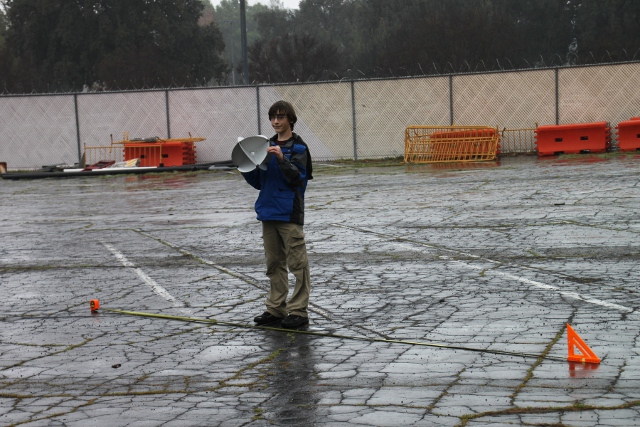
The metal thing Benjamin is holding is a radar reflector. Its purpose is to help
the radar see you. Boats put them at the top of their mast to help other boats
see them. Note the tape measure on the ground.
We ran into two problems with the mirrors though. The first was that we left the stand (fortunately with only one of the mirrors in it) unattended, and the wind blew it over and broke the mirror. Oops. The second problem was more serious. It turns out that the thin optical mirrors that we had were not good reflectors of a radar beam. They did reflect it some, but it would have been hard to distinguish the radar beam from the noise. Darrell (another coworker) suggested that a 2' x 4' metal sheet that they had nearby would reflect the radar beam much better, and we decided to go with that instead of the mirrors, and set it up so that it was 4' wide.
Here is the stand with the "mirror" in the 4 foot position
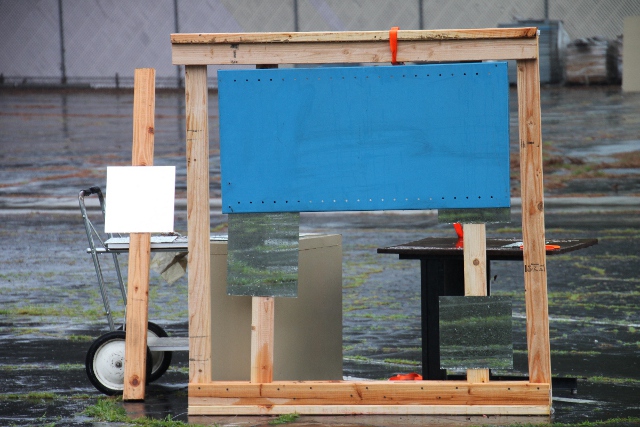
You can see one of the orginal 1 foot mirror sections that we left in the stand.
Here is the stand with the "mirror" in the 2 foot position
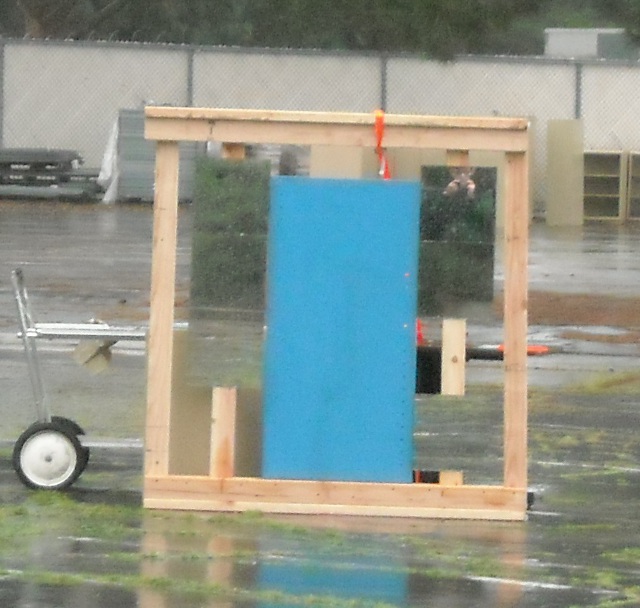
Our next problem was that the program that writes the data to the computer hard drive was encountering errors writing to the disk and aborting part way through our experiment. The first five runs all failed part way through. Eventually we told the program to write to a different drive, and that appeared to solve the problem. So we started the experiment and Marc stepped to his right 4 times, and then stepped to his left 8 times and then stepped to his right 4 times, all in two foot increments. I videoed Marc as he did this, so we would know exactly where he was at all times. Stuart recorded 2 minutes of radar data. We then repeated the experiment. Next we turned the sheet of metal sideways so that it was 2' wide. We performed the experiment with the "mirror' at 2'. However, when we repeated the 2' experiment, the program again encountered errors writing to disk, and aborted midway through the experiment. Between the problems with the mirrors and the problems with the disk, we had already spent quite a while on this experiment, and since this was in the middle of a work day, and none of us were getting paid for it, we decided to go with the data we had and not do any more runs.
Here is Benjamin at the Radar display:
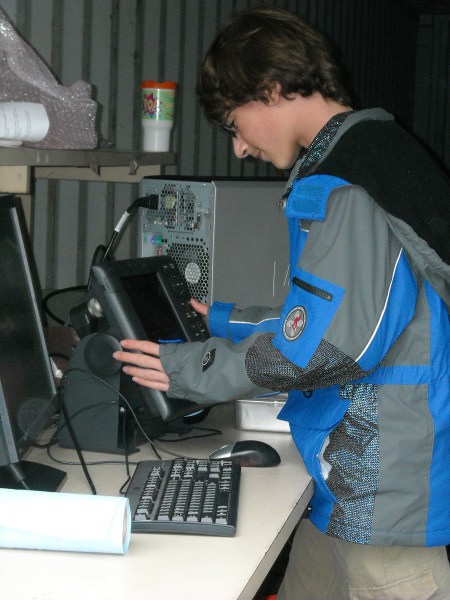
The next problem we encountered was that there were errors in the data we collected. Heather (my coworker that wrote the program that turns the raw data into something that can be easily analyzed) could fix them, but this wasn't going to be easy. Fortunately, this was resolved when Heather and I took a look at the data together. We realized that we only needed one cell's worth of data (the cell where Marc had been standing) and this particular cell did not have errors in it.
Here is the Radar display:
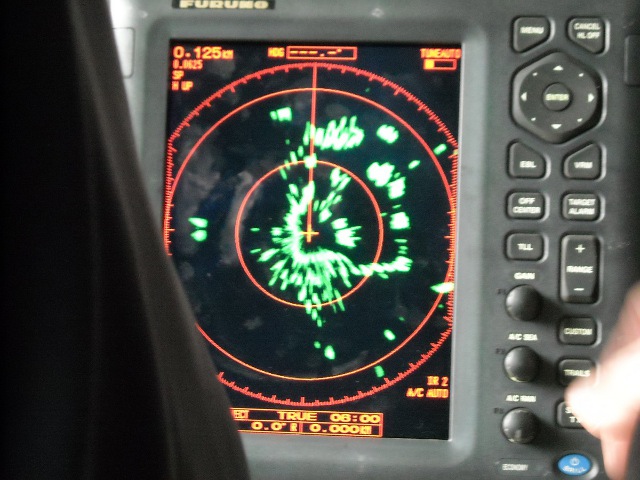
An here is the one cell we wanted:
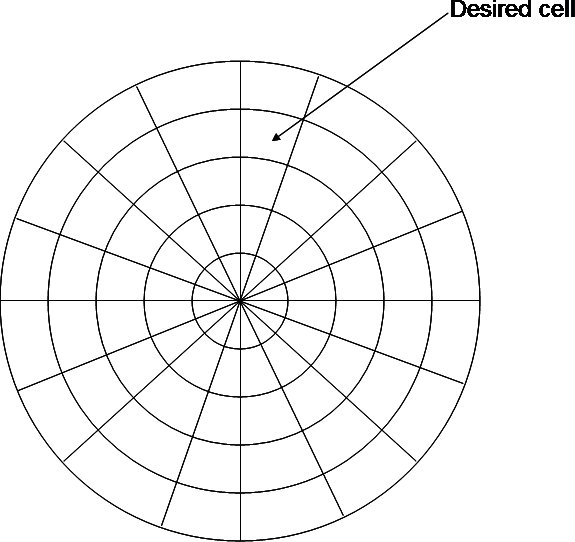
Now, we had radar return over time - 99 values at 1.2 second intervals for each of 3 runs. The three runs were the two good runs with the "mirror" at 4' wide and one good run with the mirror at 2' wide. The next step was to figure out where Marc was for each time. We downloaded the video we took onto the computer and used a program to step through the frames. We could tell where Marc was at any time and Benjamin noted start and stop times for each of the 9 positions that he was in as he moved down the tape measurer. The next step was to match up Marc's position with the radar return. This was difficult because we didn't have any way to connect the start of the radar data collection with a particular time on the video tape. This was the biggest mistake in planning the experiment that we made. In the end, I plotted the radar data vs. time, and I plotted Marc's position vs. time and shifted the time so that the curves matched up. This revealed yet another problem. In the first good run, Marc took more than 2 minutes to make all his steps, and thus we didn't have radar returns for the last 3 positions in the first run. Sigh.
Despite all the problems, Benjamin was able to reach some preliminary conclusions. The average beamwidth for the runs with the mirror at 4' was 8'. The average beamwidth for the runs with the mirror at 2' was 5.3'. So the wider mirror produced a wider beamwidth. The mirror does not act like an antenna, but instead just bends the beam. Of course it would be nice to have had a dozen runs instead of just three, but all in all it was a fine middle school science experiment.
Marc objected to the amount of adult involvement in the experiment. While Benjamin made the final decision on what the experiment topic was, all the suggestions came from adults, not from him. Many of the details were also proposed by adults (mostly me.) For the actual data collection, Stuart set up the computer program to record the radar. He could have Benjamin press the button to start the data collection, but he didn't. Benjamin could have run the video camera, but since he had never done that before, he asked me to do it. And Heather extracted the data we wanted from the volume that we collected.
When we got to the data analysis stage, first I took a look at the data and figured out what needed to be done. I had Benjamin determine the position vs. time data, but I gave him detailed instructions on what he should do to get this data. Then I looked at the radar vs. time data and the position vs. time data and figured out how to resolve the issue with the start time. One of the things I did that helped a lot in this issue was to plot the position vs. time where position was given in "feet from the closest end point." This results in a graph that looks like a "W." The graph of the radar return vs. time also looks like a "W." Changing the definition of position made it much easier to line up the start times. After I had figured out how *I* would analyze the data, I sat Benjamin down in front of the computer and had him do it. He learned how to create a pivot table and how to create the graphs.
Here is the graph of Radar return vs. position number
(there were 18 position numbers.)
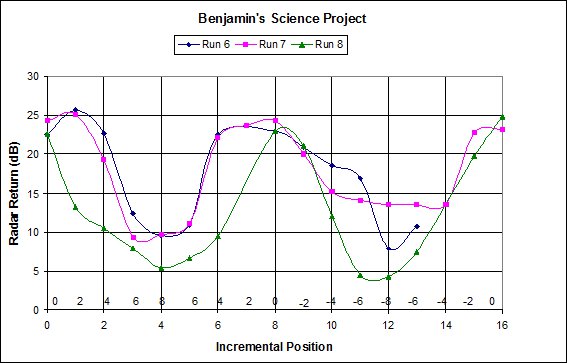
Note that each of the three runs took the shape of "W." That is,
the radar return was high when the target was in the middle at the start,
low when the target got to the end of the tape measurer, high when the target
returned to the middle of the tape measurer, low when the target reached the
other end, and high a third time when the target returned to the middle.
Here is the graph of Radar return vs. position
(where position is the number on the tape measure.)
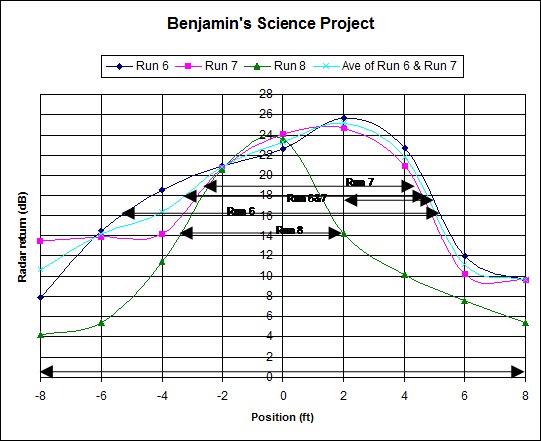
Benjamin used this graph to determine beam width, and the beam widths for each
run are marked on the graph.
I also would not let him get away with his first try in creating the report. I didn't write it for him, but gave him numerous suggestions on what to include, and lots of feedback on what he said. I also made sure that the poster lived up to my standards, although he did generate everything that went on it. He double matted everything on the poster, which looked very nice.
So I was probably more excited than he was when his experiment was chosen (along with half the other experiments in his class) to participate in an annual middle school science fair at CSUN. We were told that if he showed up for the fair and presented his work to the reviewers, that his abstract would be published in a journal of middle school science abstracts. I thought it would be very cool to be able to say he was first published at the age of 13! The science fair was the day before Easter, which was the second weekend of spring break. So imagine my chagrin when, on Wednesday, Benjamin mentioned that he had been told (repeatedly) to bring his poster home from school; that he was responsible for delivering it to CSUN on Saturday. However, it was still at school, which was (of course) closed for spring break. We briefly explored the possibility of getting into the school (apparently some other family did manage to get a janitor to open up the requisite classroom so that a child could retrieve a poster!) However, we discarded this option when it occurred to me that Benjamin could just make up a second poster. He needed to have a poster of his work as CSUN, but it didn't need to be the original poster. So that's what Benjamin did. Marc bought another poster board and more paper for matting, and Benjamin printed out all the text, pictures and graphics again, cut a whole new set of mats, and pasted them onto the poster board. We all went to CSUN and Benjamin presented his work to several CSUN students. Someone had convinced that spending their Saturday morning reviewing middle school science projects would be more fun than sleeping (or maybe they got class credit for it - I don't know.) There was an award ceremony with way more speeches than I would have liked and every kid got a medal for participating. I was expecting that the best projects would get something extra, but no.
Benjamin describing his experiment to a CSUN student:
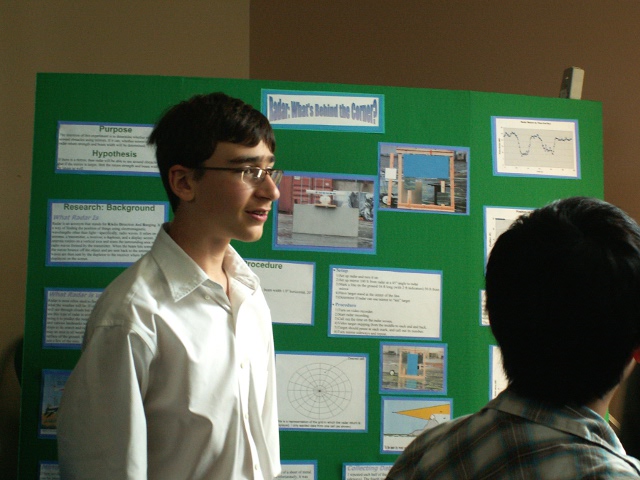
Marc and I never did come to an agreement regarding the heavy adult involvement in Benjamin's science experiment. I had seen my boys do one awful experiment after another, and given the once in a lifetime chance at doing an experiment with a real radar, I wanted him to do a decent experiment. If it took a *little* parental involvement to get there, what was the harm in that? Marc didn't really have a problem with how much I was involved, he just thought we should not refer to it as "Benjamin's science experiment" - we should call it "Jackie's science experiment"!
Posted on 06/09/2011.